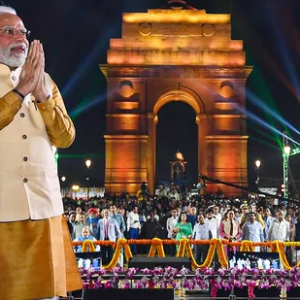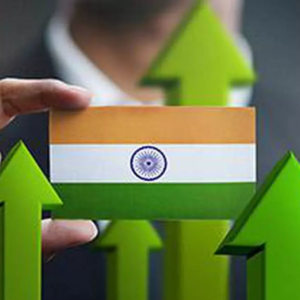~ By Priyang Pandey
Black money is a term used for monetary transactions that evade taxation by avoiding the usual banking system; these transactions tend to create a parallel economy within the existing economic ecosystem. These transactions however do not contribute to the national income. As per reports, the size of India’s black money economy is estimated between 23 to 26 percent of the GDP. Black money being unaccounted becomes a major source of corruption and for many criminal and anti national activities including acts of terrorism, drug trafficking etc. Consequently, it poses a grave threat to national security. In view of this, large stockpiles of currency notes with private parties also enables anti-India powers to print fake currency notes and circulate them with impunity.
The NDA government before coming to power had come with a solemn commitment to fight the nefarious evil of black money. Consequently, in the very first cabinet meeting of the Government, an SIT (special investigation team) was constituted to look into the cases of black money stashed abroad in various tax havens. However, in addition to this, a significant step towards fighting black money was the introduction of ‘Prime Minister’s Jan Dhan Yojana’ (PMJDY), a financial inclusion scheme with a mission based approach for providing a bank account to every household in India. The scheme facilitated opening of bank accounts for marginalised sections of the society, who hitherto had no access to banking facilities.
As per the official data, the actual target achieved was much more than the set target of 15 crore accounts till 26th January, 2015. PMJDY accounts have been offered with the zero balance facility; but the excitement of new account holders turned this into a huge pool of Rs. 19,990.52 crore which by itself is a landmark achievement. PMJDY also offers a Ru-pay debit card to every account holder, this is to familiarise people with card transactions, so that more and more people use banking channels to make their routine transactions. Financial inclusion by all means is a significant step towards the full-fledged war against corruption and black money.
Curbing and eliminating black money needs strong political will power as well as a dedicated approach. There were many half baked steps taken by the previous Governments to contain corruption and act on the black money issue, but they all failed to attain their primary objective. There may have been many reasons for the failure, but there is a need to fight back with a target based approach. In the past many anti-corruption crusaders have talked about demonetising higher denomination currency notes, with the obvious intention of pushing people to use banking channels. However, these steps were often opposed on the premise that the rural and marginalised sections of our society do not have access to banking channels. However, after the success of PMJDY, the government can intend to go ahead with the demonetisation of higher value currency notes, once people become more familiar with the modus operandi of their respective accounts. RBI has already taken the first step by demonetising currency notes printed before 2005. This will also prevent circulation of counterfeit currency, as most of the fake currency is printed in higher denominations, so as to make it economically beneficial. ISI has for long been printing fake Indian currency notes and this has been used to promote various anti-national activities within India.
PMJDY will also allow the government to pay money for various schemes run by the government, as well as for the subsidies, directly to the beneficiaries, thereby eliminating middlemen who by itself are a major source of corruption. Direct cash subsidy transfer has proved to be a major initiative to make the subsidy model leak proof, as well as to ensure that subsidies are not given to those who do not deserve.
Use of credit/Debit cards helps in making all cash transactions transparent. According to a survey, only 14 per cent Indians hold credit cards. Only 2 per cent spend more than Rs 18000 per month, this accounts for an average expenditure of around Rs. 350 per month per person. If these figures are correct, not more than 8 per cent of India’s income is spent through credit cards. That is too small a number to check black money. It is therefore necessary for the government to incentivise card and banking transactions, so that people are attracted to use banking transactions over cash. It is expected that with the help of the recently launched Digital India initiative, a majority of account holders will now have the facility of branch-free banking through smart phones. With some added incentives, it should be feasible to raise the proportion of online transactions. Recently the government decided to waive off the taxes incurred on card payments at some merchant outlets as well as websites like IRCTC, this may well be considered as a small step towards incentivising card or cash-less payments. However, the government may need to reduce service tax from card transactions to make its usage more attractive.
Recently, the government also launched MUDRA Bank to facilitate the financing of micro units or small scale entrepreneurs. As per the NSSO survey, 90 per cent of the non agricultural jobs are created by these micro units and small scale entrepreneurs. By extending easy loans through last mile financers, which in most of the cases are commercial banks; unit holders can be motivated to use the banking route as the only mode for monetary transactions. This step will lessen cash transactions substantially and the activity of these unit holders will come into the account for GDP calculation through the banking system. According to various reports, the inclusion of these micro units and small entrepreneurs in the national income will result in an overall increase of at least seven to nine percent in GDP.
To sum up, Jan Dhan Yojana, which has been a successful tool of financial inclusion can be used to draw people away from cash transactions and towards usage of various banking channels. This in times to come can greatly reduce corruption. By demonetising higher value currency notes, the government can eliminate a huge proportion of Black Money stashed in various vaults, both in India and abroad. Government needs to utilise the ability of its newly constituted think-tank ‘NITI Aayog’ as well as other agencies to ideate and come up with more efficient utilisation of huge addition of new account holders to the banking channels and utilise this tool of financial inclusion to curb corruption and eliminate black money, which has a major evil for India.
Priyang Pandey is a Research Associate with India Foundation. The views expressed are his own.


